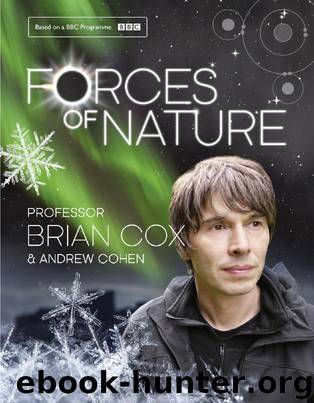Forces of Nature by Professor Brian Cox

Author:Professor Brian Cox [Cox, Professor Brian]
Language: eng
Format: epub
Publisher: HarperCollins Publishers
Published: 2016-06-21T06:00:00+00:00
Spacetime calculations
Monet and the aviator
Monet and the aviator.
We can use Einstein’s two postulates to show why it is that the aviator and Monet measure different intervals of time between any pair of events. This is surely one of the most bizarre ideas ever to come out of a human being’s head. It is all the more bizarre for being demonstrably correct. The argument is surprisingly simple. First let us imagine a special type of clock – at the end we will show that the argument must work for any type of clock, but for now we will consider a ‘light clock’. A light clock is made up of two parallel mirrors with a beam of light bouncing back and forth between them. Suppose that the two mirrors are a distance d apart. If light travels at a speed c it will take a time t=2d/c for the light to travel from one mirror to the other and back again, as determined by someone who is holding the clock (more formally, we might say ‘by someone who is at rest relative to the clock’). Let us refer to the person holding this clock as (and here we will not bother exercising our imagination) ‘person A’. Now let’s introduce a second person: ‘person B’. If person A and person B are both at rest relative to each other then both will clearly agree on how long the light clock takes to tick (let’s call one tick of the clock the time it takes for the light to make one round-trip, i.e. t=2d/c). Pre-Einstein, and according to common sense, we’d say that the clock takes this time t to tick, regardless of what it is doing or who is doing the measuring. But that is wrong, as we are about to show.
Hyperbola.
Download
This site does not store any files on its server. We only index and link to content provided by other sites. Please contact the content providers to delete copyright contents if any and email us, we'll remove relevant links or contents immediately.
Tools of Titans by Timothy Ferriss(7815)
Turbulence by E. J. Noyes(7702)
Astrophysics for People in a Hurry by Neil DeGrasse Tyson(5002)
Secrets of Antigravity Propulsion: Tesla, UFOs, and Classified Aerospace Technology by Ph.D. Paul A. Laviolette(4994)
Design of Trajectory Optimization Approach for Space Maneuver Vehicle Skip Entry Problems by Runqi Chai & Al Savvaris & Antonios Tsourdos & Senchun Chai(4843)
Room 212 by Kate Stewart(4739)
Pale Blue Dot by Carl Sagan(4618)
The David Icke Guide to the Global Conspiracy (and how to end it) by David Icke(4381)
A Journey Through Divination and Astronomy by Publishing Pottermore(4250)
Apollo 8 by Jeffrey Kluger(3512)
Goodbye Paradise(3446)
Losing the Nobel Prize by Brian Keating(3425)
COSMOS by Carl Sagan(3348)
The Five People You Meet in Heaven by Mitch Albom(3335)
How to Read Water: Clues and Patterns from Puddles to the Sea (Natural Navigation) by Tristan Gooley(3240)
Brief Answers to the Big Questions by Stephen Hawking(3239)
How to Read Nature by Tristan Gooley(3079)
The Order of Time by Carlo Rovelli(3073)
A Brief History of Time by Stephen Hawking(2819)
